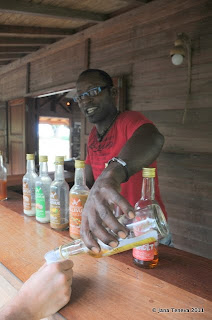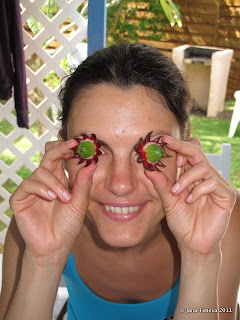Thursday, 27 January 2011
Caribbean sea movies...
Next one is a photo of a shy long nose seahorse and one showing how big aquarium Reserve Cousteau in Guadeloupe is....
Enjoy!
Sunday, 23 January 2011
"Chez Henri": blues-jazz concert and good mood Caribbean vibes...
Last weekend (on saturday, 16.01.2011) a great Blues&Jazz Fusion event took place in Saint-Louis, Marie-Galante. It was hosted by Henri, in his cozy restaurant "Chez Henri" located on the beach...Sitting under the huge breadfruit tree and with toes in the sand we had the big pleasure to listen to several artists.
First the Jocelyn Menard Quartet opened the concert with lovely jazz music and put everyone in good mood. Then Gino Sitson from Cameroun presented his new album.
And last but not least the night arrived with the amazing voice of Roland Tchakounte, an African Blues-singer, accompanied by the great sounds of his guitarist...
The bar-restaurant "Chez Henri" is known and famous place for musical events in the French Caribbean. The house is actually the birth house of Henri, who restored it some years ago. When you have the chance to get there, dont miss to try his famous "omelette creole" too, together with one "´ti punch" of course....while looking at the sea, under the (above mentioned) bread-fruit tree:-)
Friday, 21 January 2011
The rum of Marie-Galante...
This entry is about the most famous (and common) product of Marie Galante: the sugar cane. From February til June every year all three rum distilleries on the island are very busy cutting the sugar cane. Once its juice is extracted, the fermenting process start and the production of the different final products: from the white rum (50 or 59 %alcohol) through the "rhum ambree" (405%) up the the old rum (40%)...
The three distilleries in Marie Galante are Bielle, Bellevue and Poisson (Pere-Labat)...Each one of them is open to visitor every morning till midday. The guests may then walk into the distillerie itself and are offered rum and punch tasting at the end.
Some interesting rum-info is summarized below. 1100 liters of juice are made from around one ton sugar cane. From this amount of juice one will get 60 liters of pure alcohol, which will gives 120 bottles of alcohol at 50%.
Sunday, 16 January 2011
Marie Galante: about the beaches and the curious crabs...

As i had mentioned in my previous blog entry, the island Marie-Galante is famous for its beautiful and not at all crowded white-sand beaches. The beaches are coming of course in set with huge coconut palm trees and plenty of signs to watch yourself because of the falling down fruits
Another nice part of the beaches are the plenty of curious crabs running around. Have a look for yourself and enjoy!
Friday, 14 January 2011
Marie-Galante: the Caribbean sugar cane island...


One of the most common landscapes while driving around the island is the one below: cows and bulls with wide sugar cane fields behind or next to them. The island exports 13 tonnes sugar every year for further treating and it uses 1 tonne..
Saturday, 8 January 2011
Intro to exotic fruits+vegetables-part 3




























































